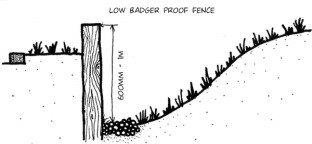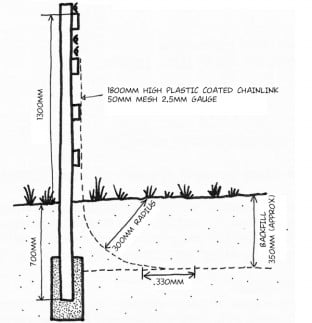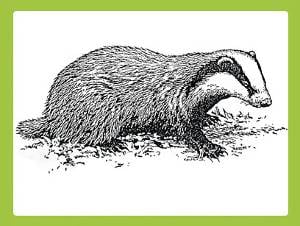BADGERS
Badgers are frequent visitors to gardens and many people welcome, and indeed encourage them. If they are visiting your garden, it is most likely that your patch is on one of the animals’ regular foraging routes.
| You can encourage them by putting out food and water on a regular basis. Then you will have the benefit of watching these beautiful animals at close quarters. Provide nutritious food, such as peanuts, raisins, and sultanas, but nothing salty. At first it may be necessary to feed them at some distance from your house, and then gradually move the food nearer to your window. |
Remember that badgers may be attracted to bird feeders if they can reach them, and deprive your birds of food. Badgers quickly become accustomed to artificial light, although they may be disturbed by security lights and by sudden movements and noises.
The activity cycle of badgers over a year
Badgers do not hibernate, but often stay below ground during the winter, particularly in cold or wet weather. They emerge from the sett just before dusk in May to November, and usually after dusk at other times. Although they mate throughout the year, the embryo does not implant until November. The cubs are born at the beginning of February, and first appear above ground in early to mid-April. They are dependent on their mother for a few more weeks until they are weaned, and learn how to fend for themselves.
Signs of badgers
If badgers are visiting your garden, there are various signs that you may observe. Badgers are creatures of habit, and they usually take the same route into and across a garden. The end result is a track worn down to bare earth.
They are very shy and peaceful animals and although they have fights about territory with other badgers they will not attack dogs cats or people - they are much more likely to run away. Other animals tend to leave them alone.
If they are pushing under fences, or through bushes, you may find hairs are left behind. They are fairly coarse, and black with a white tip and base. They are flat on one side, and will not roll between your fingers.
They are very shy and peaceful animals and although they have fights about territory with other badgers they will not attack dogs cats or people - they are much more likely to run away. Other animals tend to leave them alone.
If they are pushing under fences, or through bushes, you may find hairs are left behind. They are fairly coarse, and black with a white tip and base. They are flat on one side, and will not roll between your fingers.
| If the ground is soft, you may find paw prints. The badger print has five claws visible and a broad main pad. A fox print has only four claws and the main pad is smaller. |  |
You may find that they start to cause damage, such as digging holes (“snuffle holes”) in your lawn, eating your carrots or daffodil bulbs, or they may raid your dustbin.
Often, these problems are temporary, but if you are not prepared to accept a certain degree of mischief for the benefit of having these fascinating wild animals as visitors, then there are some measures you can take to reduce their impact.
This page gives some general advice on dealing with these problems, but it should be remembered that every situation is different, and needs to be considered as an individual case. If the problem persists, you may wish to seek advice from an experienced badger expert.
Badger problems: advice to householders from Natural England can be downloaded here.
Badgers and lawns
Badgers are attracted to lawns because of an abundant supply of worms and leatherjackets. In damp weather, they will dig for worms, when they are closest to the surface, so this is not generally a problem during the summer months.
Although removing the worms and insects should stop the damage, this is likely to require the use of vermicides or insecticides. Cabaryl or rotenone containing preparations are probably most effective. From an environmental point of view, the use of pesticides is not desirable, and their use will also deprive garden birds of their food. Chemicals may be harmful to children and pets, and must be used strictly according to published guidelines.
A more environmentally-friendly option is to allow your grass to grow longer, which makes it less attractive to foraging badgers, and so should reduce the problem.
Although removing the worms and insects should stop the damage, this is likely to require the use of vermicides or insecticides. Cabaryl or rotenone containing preparations are probably most effective. From an environmental point of view, the use of pesticides is not desirable, and their use will also deprive garden birds of their food. Chemicals may be harmful to children and pets, and must be used strictly according to published guidelines.
A more environmentally-friendly option is to allow your grass to grow longer, which makes it less attractive to foraging badgers, and so should reduce the problem.
Flowerbeds
If persistent digging of flowerbeds is a problem, a heavy-duty wire grid buried just below the surface will stop digging, but allow the plants to grow through.
Chemical deterrents
A number of proprietary formulations claim to deter cats, dogs, foxes, and badgers, but they are not guaranteed to be effective. It is important that any of products are used in accordance with the instructions, and they may affect domestic animals.
Fencing
If you wish to prevent badgers entering your garden, the first step is to establish where they are coming in, and to block off the entrance, if this is feasible. Fences and walls may provide a physical deterrent, but remember that badgers can both climb and dig.
 | Fences need to be buried below soil level and be high enough to prevent the badger climbing over; walls need to be smooth, without foot or claw holds. A permanent chain-link fence can provide long-term protection, but is obviously a fairly expensive option! |
| Electric fencing can be a very effective method of keeping badgers out of a particular area; if a badger makes contact with its nose, then it will certainly get a shock and will not be keen to repeat the experience. Two types of electric fencing are available - rabbit “Flexinet”, a mesh fence or single strands of “Polywire”. Polywire is most effective against badgers, with two strands used at heights of 7.5cm (3") and 20cm (8") from the ground. The strands must be supported at regular intervals, and powered by a suitable energiser unit, which can be powered either from the mains or a car battery. |  |
What should I do if I know badgers are present on a development site?
Badgers are legally protected species that are frequently encountered on development sites. The presence of badgers may be a material planning consideration. However, although badger setts are protected from interference by law, their foraging grounds are not. The fact that badgers occasionally visit a site proposed for development or cross it to reach another site may not, in itself, constitute a material consideration.
If there is known to be a badger sett on, or adjacent to, a piece of land proposed for development, you should inform the planning authority and/or ecology section. Under these circumstances, it is the responsibility of the applicant to provide information to enable the planning authority to determine the impact of the development upon badgers.
The information which is required is:
If there is known to be a badger sett on, or adjacent to, a piece of land proposed for development, you should inform the planning authority and/or ecology section. Under these circumstances, it is the responsibility of the applicant to provide information to enable the planning authority to determine the impact of the development upon badgers.
The information which is required is:
(a) a survey, which identifies presence/absence; population size, location of setts, runs etc.
(b) an assessment of the development’s impact on the badgers
(c) a mitigation strategy.
It is generally necessary for the applicant to employ the services of an experienced, licensed badger worker to obtain this information.
Provided the necessary supporting information is made available to allow proper determination of an application, the local planning authority should attach planning conditions or obligations as appropriate to help ensure that the intentions of PPS9 are realised. For example, if an appropriate mitigation strategy is provided as supporting information, a condition should be attached requiring the implementation of a detailed mitigation plan.
Ultimately it is for the developer to ensure compliance with the law during the actual implementation of the development, not the planning authority. It is for the planning authority to monitor whether planning conditions are being properly discharged.
The council only has authority to enter the land if there is a current planning application or a consent is being implemented. In all other cases, this is a matter for the police wildlife liaison officer. Complainant should phone the main police switchboard 0845 045 45 45 and ask to speak to a Wildlife Liaison Officer for the Isle of Wight
(c) a mitigation strategy.
It is generally necessary for the applicant to employ the services of an experienced, licensed badger worker to obtain this information.
Provided the necessary supporting information is made available to allow proper determination of an application, the local planning authority should attach planning conditions or obligations as appropriate to help ensure that the intentions of PPS9 are realised. For example, if an appropriate mitigation strategy is provided as supporting information, a condition should be attached requiring the implementation of a detailed mitigation plan.
Ultimately it is for the developer to ensure compliance with the law during the actual implementation of the development, not the planning authority. It is for the planning authority to monitor whether planning conditions are being properly discharged.
The council only has authority to enter the land if there is a current planning application or a consent is being implemented. In all other cases, this is a matter for the police wildlife liaison officer. Complainant should phone the main police switchboard 0845 045 45 45 and ask to speak to a Wildlife Liaison Officer for the Isle of Wight
Remember that badgers are a protected species, and even if they are causing a nuisance, you cannot do anything to cause them actual harm. They are protected by the Badgers Act 1992, and it is an offence to kill, persecute or trap them, or interfere with their setts.
For further advice contact:
- National Federation of Badger Groups (NFBG) tel. 0207 498 3220;
- Badger Action Group - Paul Creer tel. (01983) 730824 (evenings).
Other information is available from:
Page last updated on: 04/11/2010






